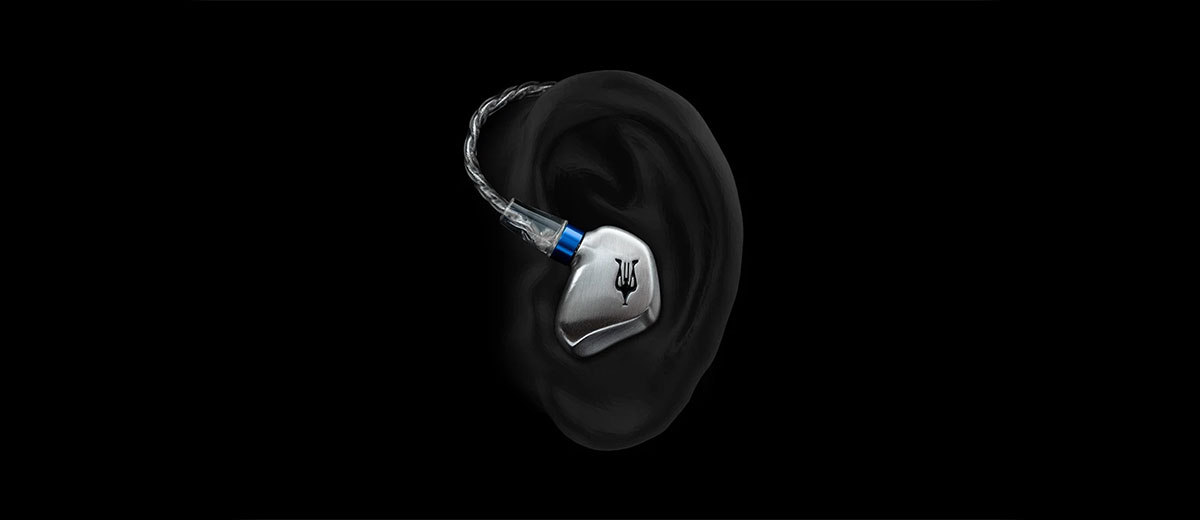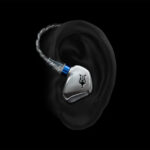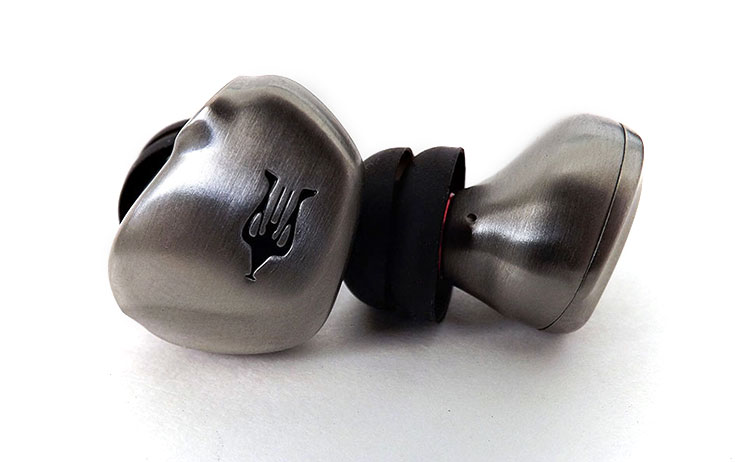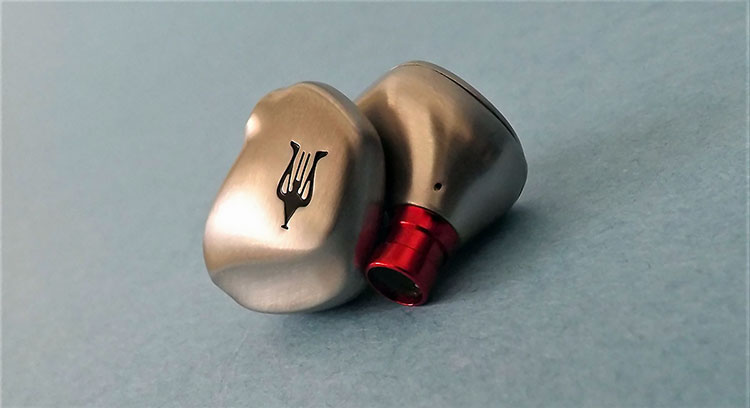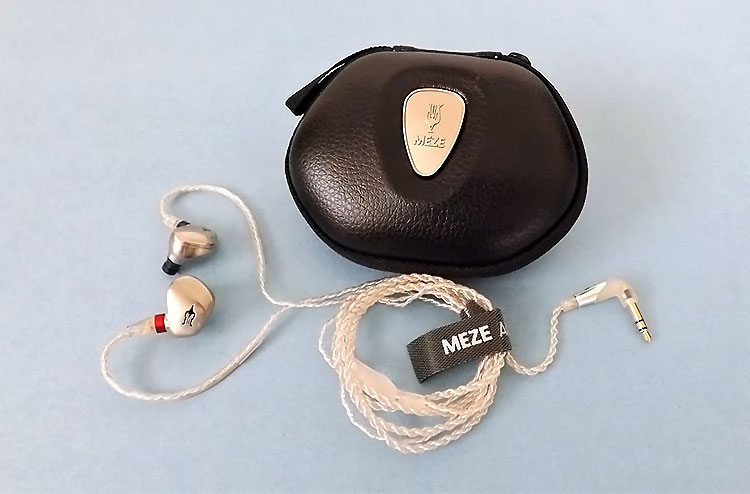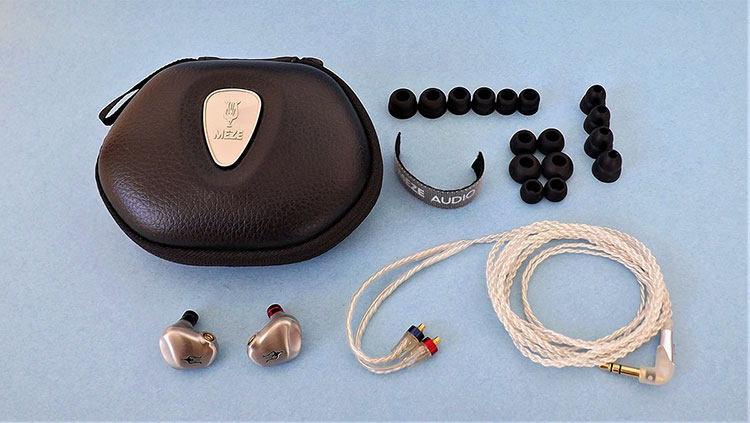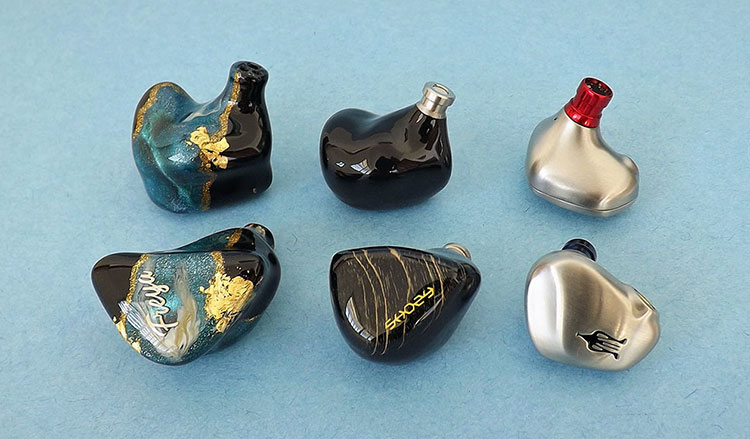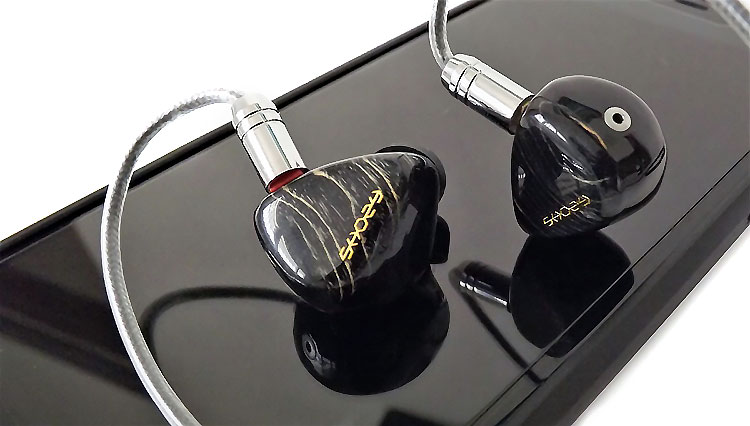Today’s review is about the Meze Rai Solo which is a single 9.9mm UPM dynamic driver universal monitor finished in an MMCX-terminated sintered steel shell. It is priced at $249.
Disclaimer: This is a sample sent to us in exchange for our honest opinion. Headfonics is an independent website that does not have any affiliate links. We thank Meze for this opportunity.
To learn more about Meze products previously featured on Headfonics you can click here.
Note, that this article follows our latest scoring guidelines which you can read up on here.
Meze Audio is a company that likes to innovate and bring us tech designs unseen anywhere else when it comes to headphones.
A very good example is their Empyrean headphones and one of our favorite cans at Headfonics receiving one of the highest scores ever only surpassed by one that is twice as costly.
Meze redesigned the Planar Magnetic conventional diaphragm design and made what they call the Isodynamic Hybrid array exclusively for the Empyrean and they sounded fantastic.
Well, Meze Audio is at it again, or, better said, they have been at it for almost 5 years now but at a much smaller size and this time with a redesign of the single dynamic driver for IEM use.
We got a set of Meze Audio’s Rai Solo in for review. The Rai Solo is a single dynamic IEM with a high-quality shell and a new twist in the IEM drive design concept.
Tech Inside
Wire-Free design
The Meze Audio Rai Solo is not a wireless earbud set. Meze Audio went to the table and redesigned the conventional dynamic IEM driver and they came up with what they call a wire-free design.
They found that the conventional driver wire connections distorted sound because of the added weight at the connection point and was responsible for an unbalanced diaphragm motion.
On large speaker drivers, this particular design does not make much of a difference. But when you are making a tiny speaker that is a full range, 10mm or less in width, and its thickness is measured in Nanometers then it does matter and Meze Audio put it into practice and on paper.
Piston motion across the driver surface is better controlled with this design by evenly distributing the conductor across the diaphragm and eliminating the source of the unbalance and hence, no driver flex.
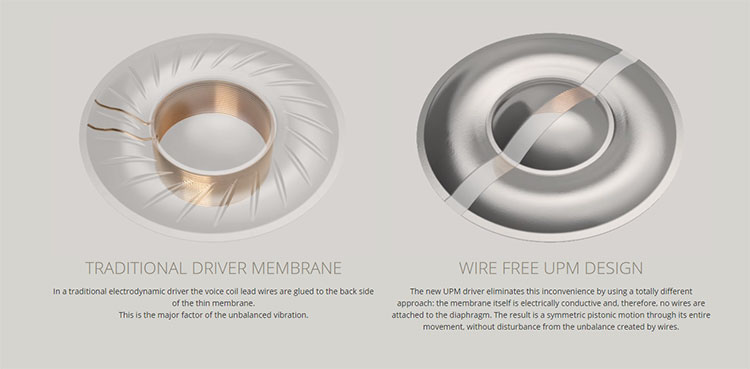
Unified Piston Motion Technology
The method used by Meze Audio of evenly distributing the connection leads across the driver itself allows for a more uniform movement of the diaphragm and prevents the shape of the cone from distorting from its original shape.
The claim is that the wire-free driver diaphragm design performs with better symmetric piston motion and practically eliminates cone flexing by eliminating the 2 voice coil feed wires. It worked and it shows.
UPM Dynamic Driver
The Meze Audio Rai Solo uses a single 9.2mm driver with a thickness of 9 micrometers. This driver is highly efficient and rated at 105db with a nominal impedance of 16 ohms.
However, do not let the high-efficiency rating fool you into thinking the Rai Solo will not scale well with higher amplification because they do. They in fact like power although they work fine on low power equipment.
The single driver handles the frequency spectrum well and is rated at 18hz to 22khz. They seem capable of decent extension in both directions. Running my usual tone test generator test I did not detect much shifting and that could only mean a very good driver pair matching and a consistent manufacturing process with these drivers.

Development Stage
Meze Audio started the development of the Rai Solo back in 2015. The almost 5-year research span started with a search for the perfect shape. Once found, the tuning stage began.
It seems Meze Audio designed the Rai Solo around the ear before anything else ensuring comfort and good ergonomics. By 2017, prototypes were being displayed at audio shows. By obtaining feedback, they were able to further tune their Rai Solo to then present a finished model in 2019.
Many people who do not understand why headphone prices are sometimes high just look here. 5 years of research and a group of people to make it all possible. All types from artisans to engineers.
Product development is extensive and the investment is huge and this explains the high cost sometimes because you are also investing in the company at that point.
Design
The Meze Audio Rai Solo shells are made of Injection Molded Stainless Steel. The finish is a brushed metal look with the Meze logo embedded into the metal and painted black. This shell has a hefty feel. The Rai Solo casing feels solid with an almost jewelry quality and appeal.
Comfort & Isolation
Of course, the Meze Audio Rai Solo is comfortable to wear because Meze Audio spent years researching and looking for the right shell shape.
Metal IEMs tend to feel cold on the ear if you live in a cold climate but most likely, stainless-steel was chosen over other metals for its ability to absorb and, or retain temperature and adjust to ear temperature quickly.
The Meze Audio Rai Solo has a low profile fit and they fit flush inside the ear. Comfort to me is top-notch and so is build.
Machined Output Nozzle
Along with the tips of the MMCX connectors on the included wire being color-coded, so are the output nozzles. These look very good and give a good reference for the correct left and right side orientation.
Good looking Nozzles. Why? Once you install flanges, you will not see them again. You engrave the inside part of a ring and never see that once it is on either, but it’s there. I like Trinkets, do you?
Cables & Connectors
The Meze Audio Rai Solo IEM uses the standard MMCX connector system and a unique Meze Audio logo branded, removable silver wire terminated in a 3.5mm single-ended male plug with a 45-degree angle. To me, the wire borders on fragile-looking but it looks to have decent enough quality.
The ear hooks are the bendable memory wire type which some consider a plus and the wire is light which is perfect for portable use and measures about 1.2 meters.
The wire is a quad twisted silver-plated copper wire in translucent insulation. The same translucent silicon is used at the Y break where the Meze logo is along with the length adjuster and even for the connectors.
Packaging & Accessories
The box proudly displays the 2 shells under a windowed flap with Meze logos up. And under that, the carrying case is displayed. Meze Audio includes a very nice hard zippered carrying case. The protective EVA case is black with the Meze logo metal badge embedded in the center.
Flanges? 8 in total. 3 pairs of silicon, 3 rubber double-flanged, and 2 deep insertion flanges are thrown in the box. A bit of information about the driver design is on the box and also on an included pamphlet and then, of course, you get the wire as well.
Sound Impressions
Summary
Once you jump the small hurdle of finding a well-fitting flange, you are greeted with a very clean, almost flat and, almost analytical characteristic because of the high microdetail production of the Meze Audio Rai Solo.
The sound signature is not completely flat and does have a very slight V shape to its character but to me flat is somewhat boring and some color is good as long as it is not overdone and that is what the Rai Solo does.
The other obvious characteristic is the dynamic range and transient response. The Meze Audio Rai Solo driver has a very good transient response and seems very dynamic in presentation with a very fast rise and decay.
The frequency response extension is very good and fairly smooth throughout. I ran the tone generator test and all frequencies were produced fairly evenly and the test also demonstrated decent frequency extension in both directions.
Bass
Sub-bass is done well and present fully but is relatively flat toned until you tickle the driver. A tiny boost in equalization shows the driver’s ability to reproduce some strong deep bass with a quick response and coherent tone even at loud volume levels.
The bass has good speed with very little to no overhang and seems very responsive. These can do party bass well and you will not feel starved of bass but I certainly would not call these bass cannons for sure.
The tone generator test took these down to 24hz but they sharply roll off after. They seem to dip fast after around 19hz and completely drop below 15hz.
The bass notes produce more in the sense of hearing notes and not in a sensory way particularly in the lower bass but sensory perceptions arise in the midbass with increased impact.
Midbass
The midbass also seems quick and responds well with music that depends on good midbass response, for instance, music with lots of drums.
Again, if you tickle the driver with some DSP or an equalizer then the midbass will become a driving force but on their own have more impact compared to the bottom frequencies. The Rai Solos do bass drums very well and have a good midbass response with good attack and with a quick, snappy quality.
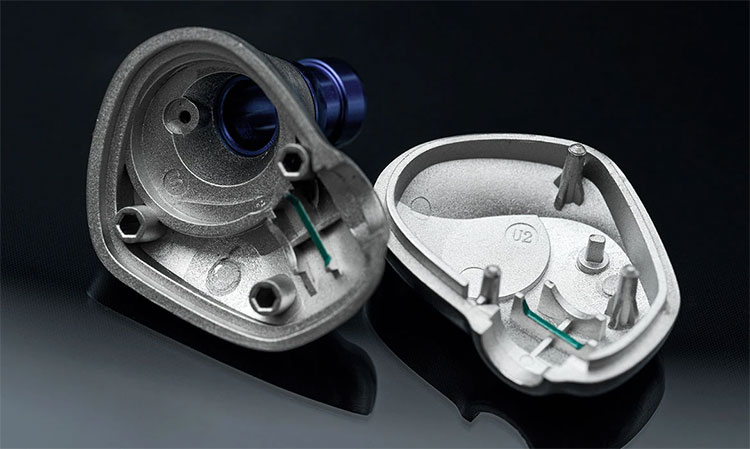
Midrange
I like the midrange presentation on the Rai Solo IEMs. There seems to be somewhat of a correct tonality in the midrange area. Or is there?
I say this because to set an example, male vocals have a girth that is not perceived when female vocals are produced. Listening to, for example, Al Jarreau on Good hands Tonight his voice sounds thicker and slightly further back than usual. The added color does sound enticing and gives his voice more emotion.
However female vocals have an edge and sometimes at loud volumes, those edges get slightly piercing along with certain instruments, particularly Saxophones.
I did perceive two small peaks, one at 1.5khz and the other around 4khz with the tone generator test, But I am not sure these small peaks give origin to the slight harshness because I think those peaks are at the wrong ranges for them to be the culprit.
Upper Midrange
It seems the upper midrange has a more forward presentation compared to the lower midrange region which is the source of the perceived and slight V shape sound. I would say it does not surpass a four or a five decibel spread across the frequency range.
The Midrange does seem to take a fairly non-offensive approach most of the time while maintaining lots of clarity and lots of microdynamics with a good, detailed wind instrument presentation. The tone and timbre are in general, natural-sounding.
Treble
The Meze Audio Rai Solo has some pretty good high in the sense that yea, they sound fairly sharp, but their best trait is the amount of weight the high frequencies have without going into sibilance, or artificiality.
I do like the way cymbals sound and you could almost sense the drumstick hitting the metal cymbal and does not sound like the common S dominant sound. This is the weight I speak of.
In the tone generator test, I did sense those peaks at 1.5khz and 4khz but I also found one at 7khz. The peaks were small and were unnoticeable listening to music. As stated before, perhaps a 5 decibel stretch across the board.
The Rai Solo highs have a decent amount of extension and clarity at the top of the spectrum but they do drop off sharply after around 16khz. Can they handle complexity? Pretty much so. The highs have good speed. They also have plenty of sparkle and shimmer.
Staging
The Meze Audio Rai Solo soundstage is fairly wide with very good placement and staging. There is also lots of perceived height. Frontal projection is good and imaging precision is very good and probably attributed to well-matched drivers.
For expansion, there is plenty of detail, microdetail, separation of instruments, choruses, and complexity is handled well except at very high volume levels where there can be some congestion.
Steely Dan’s Everything must go track intro is a good example of audio complexity and on most IEMs that intro sounds like a garbled mess but the Rai Solo handled the complexity well keeping everything identifiable within the track.
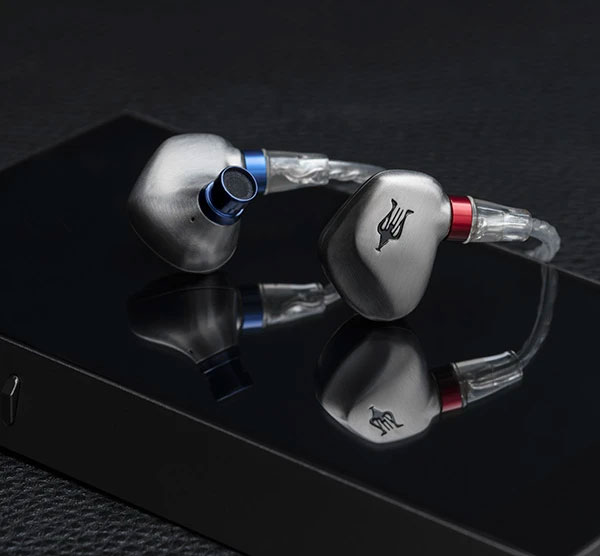
Synergy
Let’s get flanges out of the way and, the Rai Solo, like many other IEMs, are somewhat picky but not too much. Honestly, once you find a flange set that gives you a good seal you will not need to source out others and are good to go. I preferred the medium single soft silicon tips and the sound signature over foam tips.
There was no need for aftermarket expensive flanges and let’s say cheaper ones did the trick in this case. I did try the deep insertion flanges, and although they gave me good sonic results I felt somewhat penetrated if I was to describe it in one word.
One piece of advice I could give is to break these in for a very long period to get their full sound quality because when I first heard them, they sounded raw and grainy with no bass but that all changed and in a very dramatic way.
The Rai Solo likes power. For example, they like the second or even the third setting on the newly released iFi Zen Can with a single-ended output of 1600mW. That is where I set the amp for my two planar magnetic full-size cans. They are efficient enough to work well with low power equipment.
Selective Comparisons
Kinera Freya
I thought it would make a nice competitor since they are both equally priced at $249 and at that price is a highly recommended IEM but are very different in configuration and technology. This is a single dynamic driver versus multi-driver hybrid design faceoff.
Are more drivers better than a single driver? Most people that are fans of point source speakers will argue that point. Crossovers are sometimes the source of sound issues within a speaker so by using one driver with the absence of a crossover you remove the issues inherent with that design.
This is also a good comparison because they tend to have a similar sound signature. The differences are that while the Kinera Freya have a smoother and more even midrange response with a touch more forwardness, the Rai solo does extremities better with a somewhat sharper vocal presentation and highs with more bite.
The highs on the Freyas are more polite with a smoother character as well but in no way recessed.
Shozy Form 1.4
I like comparing IEMs that I recently used because they are still fresh in memory.
Similar to the Freya, and at $199, the Shozy Form has a more artistic aspect when it comes to the shells while the Meze Audio Rai Solo has more of a jewelry metallurgic aspect. They all have a high level of comfort.
I would consider the Shozy form to be right below the Rai Solo although it uses a 5 driver hybrid design when it comes down to sound quality. However, the cost is about 50 dollars less on the Shozy Form so you’ll save some money there.
Once again, polite and recessed highs on the Shozy Form 1.4, more so than on the Freya, and will be better for people who dislike sharp treble and prefer a warmer sound signature.
The bass output is cleaner on the Meze Audio Rai Solo and perhaps the high but are most definitely more pronounced as well.
Our Verdict
The Meze Audio Rai Solo is at this time in a class by itself because there are not many IEMs at this price with a single dynamic driver that sounds this good. Heck, not many multi-driver setups either.
I would describe the Meze Audio Rai solo as an IEM with a robust build, low distortion, dynamic and clean sounding, slightly V-shaped sound with good bass and sharp highs, and a fairly crisp midrange section with tons of microdetail. To top it off you get some decent accessories.
Would I change anything? Perhaps more flanges. Perhaps a more robust wire.
I honestly think the Meze Audio Rai Solo is a well priced IEM that gives you more than what you pay for in quality of build and sound quality. I dare say, this is the point in time where the conventional dynamic driver has finally matured. Good job Meze.
Meze Rai Solo Technical Specifications
- Driver: 9.2mm UPM dynamic driver
- Diaphragm thickness: 9 Micrometre
- Impedance: 16 Ohms
- SPL: 105 decibels +/- 3db @1mW/1kHz
- Frequency Response: 18hz to 22khz
- Distortion: less than 1% @ 1mw/1khz
- Stock Cables: MMCX connectors ending in 3.5mm 3 pole
- Warranty Period: 2 years

